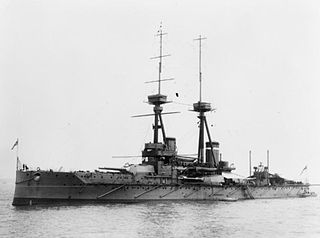Related Research Articles
Seven ships of the Royal Navy have been named Warspite. The origins of the name are unclear, although it is probably from the word spight – an Elizabethan-era spelling variation of both spite and speight – in part embodying contempt for the Navy's enemies, but which was also the common name for the green woodpecker, suggesting the 'Warspight' would poke holes in enemy ships' (wooden) hulls. Until 1919 a woodpecker was used as the ships' crest; the official badge was a cannon, although the woodpecker continued to be used on the ships' tompions or gun muzzle plugs. Warspite carries the most battle honours of any ship in the Royal Navy, with the sixth Warspite being awarded fifteen of them.
Sixteen ships and two shore establishments of the Royal Navy have been named HMS Fox, after the fox.
Two ships of the Royal Navy have been named HMS King George V, after George V, King of the United Kingdom, whilst another was planned:

HMS Collingwood was a St Vincent-class dreadnought battleship built for the Royal Navy in the first decade of the 20th century. She spent her whole career assigned to the Home and Grand Fleets and often served as a flagship. Prince Albert spent several years aboard the ship before and during World War I. At the Battle of Jutland in May 1916, Collingwood was in the middle of the battleline and lightly damaged a German battlecruiser. Other than that battle, and the inconclusive action of 19 August, her service during the war generally consisted of routine patrols and training in the North Sea. The ship was deemed obsolete after the war; she was reduced to reserve and used as a training ship before being sold for scrap in 1922.
Eight ships and a shore establishment of the Royal Navy have been named HMS Centurion, after the centurions of ancient Rome. A ninth ship was planned but never built.
Eleven ships of the Royal Navy have borne the name HMS Superb, or HMS Superbe:

Rear Admiral Sir Horace Lambert Alexander Hood was a Royal Navy admiral of the First World War, whose lengthy and distinguished service saw him engaged in operations around the world, frequently participating in land campaigns as part of a shore brigade. His early death at the Battle of Jutland in the destruction of his flagship HMS Invincible was met with mourning and accolades from across Britain.

Six warships of the Royal Navy have been named HMS Marlborough after the Duke of Marlborough:
Four ships of the Royal Navy have been named HMS Bellerophon after the hero Bellerophon in Greek mythology. The name was also initially intended for two Minotaur-class cruisers, but in both cases the ship was renamed at an early stage.

Three ships of the Royal Navy have been named HMS Benbow, after Admiral John Benbow:
Five major warships and one shore establishment of the Royal Navy have been named HMS Thunderer :
Eight ships or submarines of the Royal Navy have been named HMS Anson, after Admiral George Anson:
Several ships of the Royal Navy have been named HMS Howe, after Admiral Richard Howe:
Five ships of the Royal Navy have been named HMS Monarch.

Four ships of the Royal Navy and a divisions of the Royal Naval Reserve have been named HMS Camperdown after the Battle of Camperdown in 1797:

Admiral of the Fleet Sir Frederick Laurence Field, was a senior Royal Navy officer. He served in the Boxer Rebellion as commander of a raiding party and in the First World War as commanding officer of the battleship HMS King George V, flagship of Admiral Martyn Jerram at the Battle of Jutland in May 1916. He went on to be Commander-in-Chief, Mediterranean Fleet before serving as First Sea Lord during the early 1930s, in which role he dealt with the response to the Invergordon Mutiny in September 1931 and ensured the abandonment in 1932 of the 'ten-year rule', an attempt by the treasury to control defence expenditure by requesting the Foreign Office to declare whether there was any risk of war during the next ten years.

HMS Collingwood is a stone frigate of the Royal Navy, in Fareham, England. It is the lead establishment of the Maritime Warfare School and the largest naval training organisation in Western Europe. The Maritime Warfare School is a federated training establishment incorporating HMS Excellent, the Defence Diving School, the RN Physical Training School, the School of Hydrography and Meteorology in Plymouth and the Royal Marines School of Music in Portsmouth Naval Base.

Admiral of the Fleet Sir Cecil Burney, 1st Baronet, was a Royal Navy officer. After seeing action as a junior office in naval brigades during both the Anglo-Egyptian War and the Mahdist War, he commanded a cruiser in operational service during the Second Boer War. As a flag officer he commanded the Plymouth Division of the Home Fleet, the 5th Cruiser Squadron, the Atlantic Fleet and then the 3rd Battle Squadron.
References
- ↑ Adams, Max (2005). Admiral Collingwood: Nelson's Own Hero. London: Orion Books. p. 276. ISBN 978-0297846406.
- ↑ "Heritage Structure Section 2 – The Principles and Eligibility Criteria for the Award of Canadian Forces Battle Honours". Government of Canada. 2 December 2021. Retrieved 20 June 2023.
It was the practice in the RCN to award new ships the battle honours won by any predecessor of the same name on a common Commonwealth list for all the Royal navies. While existing ships (and one air squadron) continue to bear such honours by right of continuous service until they are paid off, new construction is awarded only those battle honours won by Canadian ships on a Canadian order of battle